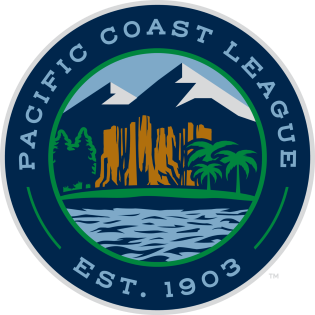
In December of 1902, the PCL was formed. It consisted of six teams. Officials from the California State League had met and granted those six franchises. They were the Oakland Oaks, San Francisco Seals, Los Angeles Angels, Portland Beavers, Sacramento Senators and the Seattle Indians. The teams would begin play in 1903. A dispute arose over the areas in which the PCL had placed franchises. These were areas owned by the Pacific Northwest League. The PCL’s allowing blacklisted players to play led the National Association of Professional Baseball Leagues to label the PCL as an outlaw league.
California’s mild climate allowed teams to play long seasons. Sometimes beginning in late February and lasting into early December. In 1905, the Seals would set an all-time record playing 230 games. Teams would regularly play between 170-200 games. This continued into the late 1950’s. One side effect of this was that it allowed many of the players who were career minor leaguers, to hone their skills and earn an extra month or two of salary, negating the need for an offseason job.

Fans in Oakland arriving opening day 1903.
The inaugural season in 1903 was 200 games long. The Los Angeles Angels compiled a 133-78 record becoming the league’s first champion. Another side effect of the long season was that players were able to establish all-time minor league records that still stand. In 1904, the NAPBL brokered terms with the PCL removing the outlaw status and classified the league as Class-A. In 1909 that was raised to AA. 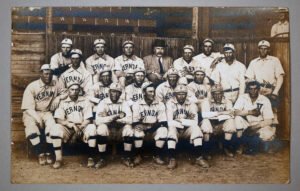
In 1919, the league added two teams, the Vernon Tigers, and Salt Lake City Bees. For those unfamiliar with Los Angeles, Vernon is a suburb of LA, it is mostly industrial now, with the Farmer John slaughterhouse as one of its more prominent structures. Through its early years, the league did not show much commercial success. This would change in the 20’s. 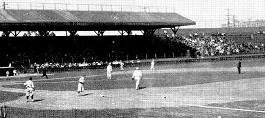
In Los Angeles, the Angels started out playing at Washington Park, a 15,000-seat stadium just south of downtown LA, photo circa 1917 above. The Oaks started at Freeman’s Park and in 1912 moved into their new park in Emeryville, an SF suburb, called simply, Oaks Park. Portland would play at Vaughns Street Park from 03 to 1955. Sacramento played in Oak Park in 1903 and would not get their own permanent stadium until 1936. Until then they played in five different venues. The Seals played at Recreation Park until Seals Stadium was completed in time for the 1931 season. Seattle originally played in Yesler Way Park, moving to Dugdale Field, built by their owner in 1913. 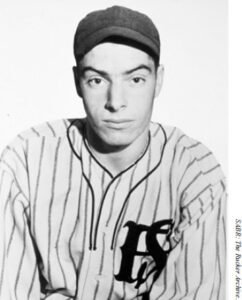
The 1920’s saw the league become commercially viable. Teams featuring star players began to make money, others did not, but the league remained successful until the Great Depression hit in late 1929. The quality of play in the league suffered due to the reduced salaries. Many future MLB stars though played in the league in the 30’s. And two teams were added, the Hollywood Stars and San Diego Padres.
Five years before any MLB team played a night game, the first night game was played on June 10th, 1930, when the Sacramento Solons and the Oakland Oaks played a game at Sacramento’s Moreing Field under the lights. This was a boost for the league’s attendance. Hollywood played their games at Wrigley Field in LA which had been built by chewing gum magnate, William Wrigley after he purchased the Angels. They would move to Gilmore Field in 1939. 
San Diego began play at Lane Field, moving to Westgate Park in 1958. Players who played in the PCL included, Joe DiMaggio, Ted Williams, Bobby Doerr, Tony Lazzeri, Joe Gordon, Paul Waner, Earl Averill and Ernie Lombardi, hall of famers. The PCL had no rival leagues the first half of the 20th century. Since there was no MLB team west of St. Louis, they had the best level of play and talent.
Many of the players listed above, were from the area. Being able to draw from this talent pool helped the league a lot. They were very prosperous during WWII, and this allowed the president of the league, Pants Rowland to begin to envision the PCL as the third major league. In 1945, the league voted to become a major league. The two existing leagues, AL and NL, were not interested though in adding the PCL to their ranks. 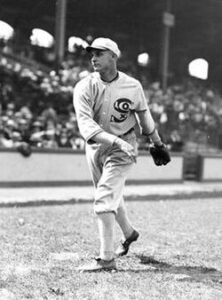
Many of the leagues’ players went on to play in the majors. But some teams were successful enough to offer competitive salaries to their star players, thus avoiding being outbid for their services. One of the more famous of these was Frank Shellenback. Shellenback set the PCL record for career wins with a 295-178 mark. His MLB career was brief, 2 years with the White Sox, 10-15 record, but he pitched 20 years in the minors winning a total of 315 games and losing 189. He won 27 games once, and 26 twice, while pitching for the Hollywood Stars in the 20’s. One proviso though, he was a spitball pitcher, and the spitball was outlawed in the majors in 1920. Shellenback with the Sox above. 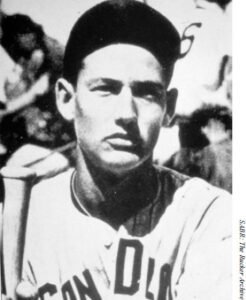
Many former MLB players would come to the PCL to finish their careers after leaving the majors. In 1952, the PCL became the first league in history to be classified as Open. That is one step above AAA. This was also an act towards becoming a third major league. Bad timing though. The 50’s would see a decline in attendance in the minors from coast to coast. This was due to MLB baseball being tele
The hammer was dropped when the Dodgers and Giants moved west in 1958. This displaced three of the league’s flagship teams to smaller markets. The Angels moved to Spokane and the Stars relocated to Salt Lake. The Seals went to Arizona. The Oakland franchise had moved to Vancouver in 1956 and become the Mounties. San Diego and Seattle would suffer the same fate when the Pilots and Padres became MLB teams. 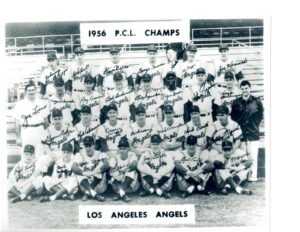
The Dodgers move to LA was facilitated when O’Malley paid Wrigley 3 million dollars for the location rights, including Wrigley Field and the Angels. When the AL was going to expand, Hank Greenburg, the Hall of Famer, was told he would have to pay O’Malley for the right to expand into what was considered the Dodgers territory. He refused, but later Gene Autry did pay the money so he could fulfill his dream of owning a major league team. The PCL began to expand across the country and internationally in the late 50’s and early 60’s. They added teams in Dallas, Denver, Indianapolis, Oklahoma City, Eugene, Hawaii, Tacoma, and Tucson in the 60’s. In the 70’s, Albuquerque and Vancouver came aboard. They had 12 teams from 64-68. Dallas folded after two years. They added Calgary, Edmonton, Las Vegas and Colorado Springs in the 80’s. 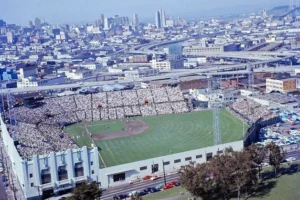
They expanded more when the American Association disbanded, adding 5 of their teams, Iowa, Nashville, Oklahoma, Omaha and New Orleans, with the Memphis team as the expansion franchise. The league now had an all-time high of 16 teams, stretching from Western Washington to Middle Tennessee. Half of the teams were located east of the Rocky Mountains. The leagues presence diminished and was gone from Canada by the early 2000’s. Seals Stadium SF above.
Vancouver moved to Sacramento and became the River Cats. They were soon replaced in that city by a short season single A team. Calgary moved to Albuquerque and became the Isotopes. Edmonton moved to Round Rock Texas in 2005. Of the cities representing the PCL in its heyday, only Sacramento and Salt Lake City remain. The Sky Sox moved to San Antonio in 2019. Because of the pandemic, there was no play in 2020. 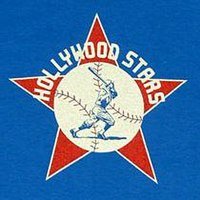
MLB took over the minor leagues in 2021, and the PCL was reduced to 10 teams. After acquiring the naming rights, it became the PCL again in 2022. There are two divisions of 5 teams each. east and West and the teams play a 150-game schedule, starting in late March and ending in late September. The league has a salary cap. As of the 2024 season they are required to spend a maximum of 1,610,000 $ in compensation with a minimum of 35,800$ per player. 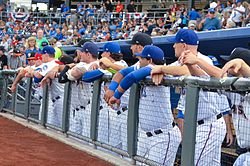
For players 23 and younger on standard contracts, only 5% of their salary counts towards the cap. (250,000) maximum. There is a different cap for coaches and technical support. 28 players can be on the opening day roster, although 9 players can be signed on the roster before the transactions date limit. The league meets the International League in a championship for AAA. The East is now comprised of the Albuquerque Isotopes, (Colo), El Paso Chihuahua’s, (SD), Oklahoma City Comets, (LA), Round Rock Express, (Tex), and the Sugar Land Space Cowboys, (Hou).
The West has Las Vegas, (A’s), but only until the A’s move there in three years, Reno Aces, (Az), Sacramento River Cats, (SF), Salt Lake City Bees, (Angels), and the Tacoma Rainiers, (Sea). The PCL set an attendance record in 2007 becoming the only minor league to reach over 7 million in attendance. 7,420, 095 the all-time high. The league continues to send future stars to the majors.
Minor League Scores
Sacramento 8 OKC 6: The Comets with Sean Linan on the mound, fell behind immediately when the River Cats scored 5 in the first inning and 1 in the third. Linan went 3.2 innings allowing 6 earned runs on 4 hits and 3 walks. He struck out 6 and allowed a first inning grand slam to former Dodger, Jake Lamb. The Comets scored 3 in the bottom of the third when Alex Freeland hit his 4th homer, a 3-run shot. Davis gave up 2 in the top of the 5th for Sacramento’s final runs. Only 1 was earned. In the bottom of the 4th, OKC got another run when Gauthier tripled in Feduccia. They scored their final 2 runs in the bottom of the 7th. Gauthier walked and Ruiz was hit by a pitch. Joey Lucchesi came in to relieve. Freeland walked, loading the bases. Ward grounded into a force out scoring 1 run, then Chavis hit a sac-fly for the final tally. Freeland was 1-4 with 3 driven and Feduccia was 2-3 with a run scored. Of note for Dodger fans, Michael Kopech pitched a clean inning with 1 strikeout.
Springfield 9 Tulsa 8: The Drillers fell behind 3-0 in the first inning, scored 3 in the 3rd and 3 in the 4th to go up 6-3. Springfield came back with 1 in the top of the 5th and 2 in the top of the 8th. The Drillers scored 1 in the bottom of the 8th to go back in front, 7-6. The Cardinals scored 1 more in the top of the 9th to tie the game and the Drillers could not score in the bottom of the frame sending the game into extra innings. Springfield scored 2 in the top of the 10th, and the Drillers could score just 1 for the final. Pagan and Ramos had 2 hits and 2 RBI’s each. Biddison, McLain and Pagan all homered.
Great Lakes 3 West Michigan 2: The Loons won a squeaker against the Whitecaps. The scored 2 runs in the top of the 1st inning on a single by Mike Sirota. Eriq Swan pitched 4 scoreless innings allowing 2 hits, walking 3 and striking out 6. He was relieved by Romero who pitched 3.2 innings, allowing 2 runs, on 3 hits and 2 walks, while striking out 2. One of the hits was a solo homer. In the top of the 9th, Sirota doubled. A wild pitch moved him to third, and the DePaula hit a ground ball that was booted for an error and Sirota scored. Hobbs pitched a scoreless bottom of the 9th for his 3rd Ranch trailing in the bottom of the 6th, 4-1. Ranch lost 5-2 to Portland. Both runs driven in by Sam Munoz, one of them on his 5th homer in the 4th inning.
Born June 14th, 1948, in Los Angeles California. AKA The Bear
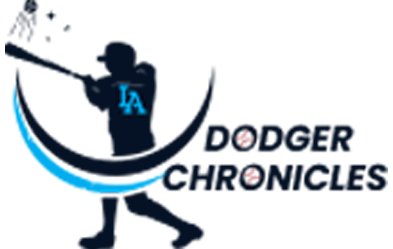












Just wanted to let you guys know that Jeff has some family functions this weekend, including his 51st anniversary. He will not be taking his computer with him, so I will be covering it all. He should be back by Wednesday. Happy Memorial Day to you all.
Bad 9th inning. Scott gives up the lead. Middle of the lineup accounted for the scoring. Ohtani, Betts, Freeman 1-11 with 5 Ks. Both the Giants and the Padres won. Bases loaded in the top of the 10th with no outs, and they do not score. Teo grounded into a force out at the plate and Max hit into an inning ending DP.
Well, it wasn’t pretty, but they managed to win. Teo player of the game with 3 driven in.
A friend of mine who grew up in San Diego told the story of how a woman in a Salvation Army uniform came into his dad’s gas station and noticed he was listening to a ballgame on the radio. “Oh, you like baseball? My son Ted plays baseball. Ted Williams. Have you heard of him?” According to my friend, she was largely oblivious to her boy’s incredible success and fame.
The all-time all-California team would feature Williams, DiMaggio, Pasadena’s Jackie Robinson and Fullerton’s Walter Johnson…
In current baseball news, the Nationals just promoted a prospect they acquired in the Soto deal. Impressive debut with two hits and strong defense. Four former Padres prospects are now on the Washington roster, including CJJames Abrams, Wood, McKenzie Gore and now Robert Hassell the 3rd, who probably should be nicknamed Trip.
A’s DFAd Seth Brown and sent JJ Bleday down to AAA. Cubs trying to get 2017 All-Star game. Tigers outrighted Tomas Nido. LHP Jake Diekman retired, Royals acquired infielder Diego Castillo from the Mets for cash. White Sox optioned Andrew Vaughn and Tim Elko to AAA. Angels won their 8th in a row and are now at 25-25 on the year. Mariners designated Jesse Hahn for assignment. Rockies DFAd former Dodger Scott Alexander.
Is the “hide replies” format going to continue here?
The 2023 Dodgers won 100 games and that roster has been almost totally revamped by AF for 2025. It’s incredible.
https://baseball-almanac.com/teamstats/roster.php?y=2023&t=LAN
This Wed had a question mark as to who would pitch ( bullpen game or call up?). Now it looks like Kershaw could make that start five days after only pitching 2 innings because of the rainout. Just my guess.
Great piece, Bear. Much appreciated.
Until Scott finds some movement on his fastball he’s going to get hit.
https://www.baseball-almanac.com/articles/strike_zone_rules_history.shtml
The strike zone. Where is it?
It’s wherever tonight’s umpire says it is.
By rule, depending on the height of the batter, it’s about 6” higher than what is actually called. If you were to search it, which I have several times, you get definitions, and representations, but the box we see every day is not what the rule book actually says it should be.
When ABS is exacted next year, will it be what the rule book says it is, the mid point between the top of the batters shoulders and the top of their uniform pants and the hollow at the bottom of the knee when the batter is ready to swing? I doubt it.
Who had this fact on their 2025 pre season prediction card? One third into the season and Ben Casparius would be our second best pitcher!!!!!
Wow, what an article of great baseball history. Absolutely love and appreciate this so very much. It was thrilling for me to see two superstars like Joe D. and Ted W. played in this league. Very cool.
So the first night game was 1930…shortly after the October 29th Stock Market Crash. I wonder how many of those pitchers-pitching in 200-230 games per season had to have arm surgery? Something tells me….not many.
I smiled when I saw the teams that the Pacific Coast League expanded to….all the way to Tennessee. A bit away from the Pacific Coast, you think? lol
Anyhow, so many details you provided….I think I will read it again to catch what I probably missed….being a speed reader.
Thanks again Bear,
TM
MLB. com has a feature on six teams that are likely “sellers” in the mid-season trade market, the most surprising being the disappointing Orioles.
The Dodgers are an offensive juggernaut. The brass, I think, will be looking at pitching at the mid-season. But here’s a rental on offense that merits consideration:
“Cedric Mullins is earning $8.725 million in his final year before free agency, and with 10 home runs, 31 RBIs, seven stolen bases and an .805 OPS in 2025, he would be an upgrade in the outfield for a number of contenders.”
That’s the kind of production we were hoping to get from Conforto, right? Instead, he’s been the weak link in the lineup.
Mullins is a legit centerfielder and he’s playing a lot better now than Luis Robert Jr., who needs to be fixed.
The Orioles need pitching. To me, Miller + Outman would be an overpay, but Wrobleski + Outman might be right. Orioles might have a special interest in Tulsa pitcher Peter Huebeck, a former Maryland high school star.
An OF of Pages-Mullins-Teo would be an upgrade, and Edman could shift to 2B.
I’m ambivalent about this idea, in part because I’d be happy with Kim getting more ABs at 2B and Rushing playing some LF.
But Mullins would be an upgrade
Any thoughts on Cedric Mullins at the deadline????
Thanks Bear, there was a lot of baseball being played on the west coast before the Dodgers and Giants moved west. There wasn’t much MLB baseball on the TV prior to those moves, mostly the Saturday morning game of the week but in the mid fifties, the LA area always had a Pacific Coast League double header.
My Dad was a Dodger fan and when I was 5 or 6 I was mostly a run around outside guy who was pulled the coach when I came inside to watch a few innings of Saturday game of the week. Apparently Duke Snider hit a couple of home runs whenever my dad could coax me to watch a little baseball with him. It was easy for me to become a Duke Snider and Brooklyn Dodger fan but prior to 1958 when the Dodgers moved west, I had watched far more PCL games on TV and live than MLB games.
I remember there were 8 teams in the PCl and out little league teams were named after those teams. South to North, San Diego Padres, Los Angeles Angels, Hollywood Stars, Sacramento Solons, San Francisco Seals, Portland Beavers, Seattle Rainiers, and Vancouver Mounties.
Steve Bilko was the big star for the Angels. He hit 55 home runs in 1956 and 56 in 1957.
Chuck Connors played for the Angels in the early fifties. He is one of only 13 athletes in the history of American professional sports to have played in both Major League Baseball and the National Basketball Association. With a 40-year film and television career, he is best known for his five-year role as Lucas McCain in the highly rated ABC series The Rifleman
Can’t walk #9’hitters!
Might be the worst offensive performance from Shohei since he’s been a Dodger. Against a LHP his right foot stepped into a bucket and he flew wide open every AB. Three k’s on the night.
Joc Pederson suffered a broken hand in today’s Ranger game.
Every team in the West lost today. Don’t see that often. San Diego is 3-7. Don’t see that often enough.
Ohtani will face hitters before Sunday’s game, which is on ESPN.